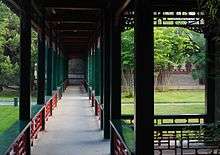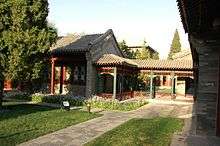Tsinghua Garden
Coordinates: 39°58′56″N 116°20′22″E / 39.982264°N 116.339379°E



Tsinghua Garden (traditional Chinese: 清華園; simplified Chinese: 清华园; pinyin: Qīnghuá Yuán) is a garden in Haidian District, Beijing, China. Constructed during the reign of the Kangxi Emperor (r. 1661–1722) in the Qing dynasty, it was originally named "Xichun Garden" (熙春园; 熙春園; Xīchūn Yuán). Later, it was divided into two gardens: Chunze Garden (春泽园; 春澤園; Chūnzé Yuán) and Hande Garden (涵德园; 涵德園; Hándé Yuán). Chunze Garden and Hande Garden were later respectively renamed to "Jinchun Garden" (近春园; 近春園; Jìnchūn Yuán) and "Xichun Garden" (its former name). In 1852, during the reign of the Xianfeng Emperor, the garden was renamed again to "Qinghua Garden" (or "Tsinghua Garden"). In the present day, "Tsinghua Garden" generally refers to the locations of Tsinghua University, Tsinghua Garden, Jinchun Garden, and other Qing dynasty gardens in the area.
History
Tsinghua Garden, originally the Xichun Garden, was granted as a gift by the Kangxi Emperor to his third son, Yinzhi (Prince Cheng). It was part of the Old Summer Palace and was called the "East Garden" (東園) because it was located to the east of the Old Summer Palace. The Kangxi Emperor visited the garden ten times when the garden was owned by Yinzhi, and celebrated eight of his birthdays at the garden, including his 60th birthday in 1713. He also wrote calligraphy for five plaques displayed all over the garden, one of which was the garden's name (Xichun Garden).
In 1821, the Daoguang Emperor divided the Xichun Garden into Chunze Garden (later renamed to Jinchun Garden) and Hande Garden (later renamed back to Xichun Garden), and granted them respectively to his brothers Mianxin (Prince Rui) and Miankai (Prince Dun). After Miankai's death, Xichun Garden was inherited by his adopted son, Yicong (Prince Dun). As Yicong was actually the fifth son of the Daoguang Emperor, Xichun Garden was loosely referred to as the "Fifth Prince's Garden" (小五爺園).
In 1852, after the Xianfeng Emperor came to the throne, he renamed Xichun Garden to "Qinghua Garden" (or "Tsinghua Garden"). In 1860, during the Second Opium War, the Anglo-French forces destroyed Jinchun Garden while burning down the Old Summer Palace. Qinghua Garden sustained little or no damage. After Yicong's death, Qinghua Garden was inherited by his eldest son, Zailian. In the aftermath of the 1900 Boxer Rebellion, Qinghua Garden was confiscated by the Qing imperial government because it had been used by Zailian's younger brother, Zaiyi (Prince Duan), as a meeting location with the Boxer rebels. The garden fell into disrepair for some years before the imperial government approved a request by the foreign affairs ministry to build a school on the land. The school, named "Qinghua School" (清華學堂), started operating in 1911. In 1913, Qinghua School acquired the former Jinchun Garden and the surrounding areas, and gradually expanded over time to become the present-day Tsinghua University.
References
- Zhang, Sijing (张思敬) (2001). History of Tsinghua University (清华大学志) (in Chinese). Tsinghua University Press. ISBN 7302043191.